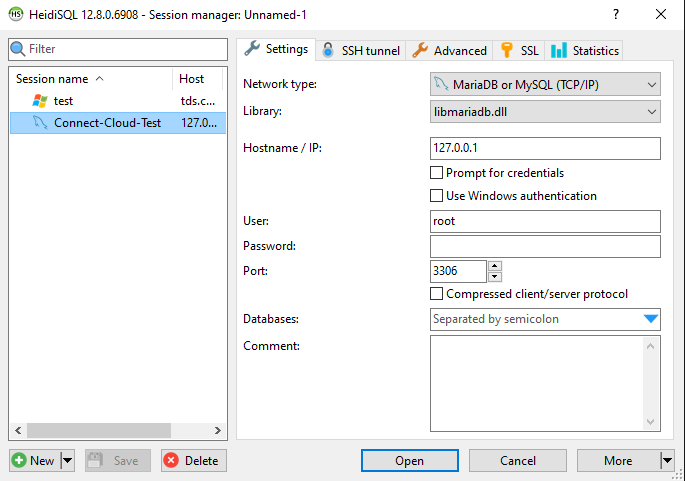Discover how a bimodal integration strategy can address the major data management challenges facing your organization today.
Get the Report →Connect to Paylocity Data from HeidiSQL
Use CData Connect Cloud to connect to and query live Paylocity data from HeidiSQL.
HeidiSQL is an open-source database administration tool that natively supports MariaDB, MySQL, SQL Server, and PostgreSQL. When paired with CData Connect Cloud, HediSQL reach extends to include access to live Paylocity data. This article demonstrates how to connect to Paylocity using Connect Cloud and query Paylocity data in HeidiSQL.
CData Connect Cloud provides a pure SQL Server interface for Paylocity, allowing you to query data from Paylocity without replicating the data to a natively supported database. Using optimized data processing out of the box, CData Connect Cloud pushes all supported SQL operations (filters, JOINs, etc.) directly to Paylocity, leveraging server-side processing to return the requested Paylocity data quickly.
Configure Paylocity Connectivity for HeidiSQL
Connectivity to Paylocity from HeidiSQL is made possible through CData Connect Cloud. To work with Paylocity data from HeidiSQL, we start by creating and configuring a Paylocity connection.
- Log into Connect Cloud, click Connections and click Add Connection
- Select "Paylocity" from the Add Connection panel
-
Enter the necessary authentication properties to connect to Paylocity.
Set the following to establish a connection to Paylocity:
- RSAPublicKey: Set this to the RSA Key associated with your Paylocity, if the RSA Encryption is enabled in the Paylocity account.
This property is required for executing Insert and Update statements, and it is not required if the feature is disabled.
- UseSandbox: Set to true if you are using sandbox account.
- CustomFieldsCategory: Set this to the Customfields category. This is required when IncludeCustomFields is set to true. The default value for this property is PayrollAndHR.
- Key: The AES symmetric key(base 64 encoded) encrypted with the Paylocity Public Key. It is the key used to encrypt the content.
Paylocity will decrypt the AES key using RSA decryption.
It is an optional property if the IV value not provided, The driver will generate a key internally. - IV: The AES IV (base 64 encoded) used when encrypting the content. It is an optional property if the Key value not provided, The driver will generate an IV internally.
Connect Using OAuth Authentication
You must use OAuth to authenticate with Paylocity. OAuth requires the authenticating user to interact with Paylocity using the browser. For more information, refer to the OAuth section in the Help documentation.
The Pay Entry API
The Pay Entry API is completely separate from the rest of the Paylocity API. It uses a separate Client ID and Secret, and must be explicitly requested from Paylocity for access to be granted for an account. The Pay Entry API allows you to automatically submit payroll information for individual employees, and little else. Due to the extremely limited nature of what is offered by the Pay Entry API, we have elected not to give it a separate schema, but it may be enabled via the UsePayEntryAPI connection property.
Please be aware that when setting UsePayEntryAPI to true, you may only use the CreatePayEntryImportBatch & MergePayEntryImportBatchgtable stored procedures, the InputTimeEntry table, and the OAuth stored procedures. Attempts to use other features of the product will result in an error. You must also store your OAuthAccessToken separately, which often means setting a different OAuthSettingsLocation when using this connection property.
![Configuring a connection (Salesforce is shown)]()
- RSAPublicKey: Set this to the RSA Key associated with your Paylocity, if the RSA Encryption is enabled in the Paylocity account.
- Click Create & Test
-
Navigate to the Permissions tab in the Add Paylocity Connection page and update the User-based permissions.
![Updating permissions]()


Add a Personal Access Token
If you are connecting from a service, application, platform, or framework that does not support OAuth authentication, you can create a Personal Access Token (PAT) to use for authentication. Best practices would dictate that you create a separate PAT for each service, to maintain granularity of access.
- Click on your username at the top right of the Connect Cloud app and click User Profile.
- On the User Profile page, scroll down to the Personal Access Tokens section and click Create PAT.
- Give your PAT a name and click Create.
- The personal access token is only visible at creation, so be sure to copy it and store it securely for future use.

Connect to Paylocity from HeidiSQL using Connect Cloud
To establish a connection from HeidiSQL to the CData Connect Cloud Virtual SQL Server API, follow these steps.
Create a new HeidiSQL Session
- In the Session Manager, select New in the bottom-left
- Give the new session a descriptive name, e.g. Connect-Cloud-Paylocity

Configure a SQL Server Connection to Connect Cloud
- In the session settings, set the Network type to Microsoft SQL Server (TCP/IP)
- The Library DLL should automatically update to MSOLEDBSQL
- Set the Hostname/IP to tds.cdata.com
- Set the User to your CData Connect Cloud username. This is displayed in the top-right corner of the CData Connect Cloud interface. For example, [email protected]
- Set the Password to your PAT created in Connect Cloud in the previous section.
- Set the Port to 14333
![Configuring a SQL Server connection to Connect Cloud]()
Query Paylocity from HeidiSQL
- In the database listing on the left, find your connection to Paylocity configured earlier.
- Expand this connection to view individual tables or data objects present within Paylocity.
- Write custom SQL queries targeting these tables, treating the data source like any SQL Server database, or visually explore each tabular data set by selecting the relevant tables
![Querying within HeidiSQL.]()
Get CData Connect Cloud
To get live data access to 100+ SaaS, Big Data, and NoSQL sources directly from your SQL Server database, try CData Connect Cloud today!









